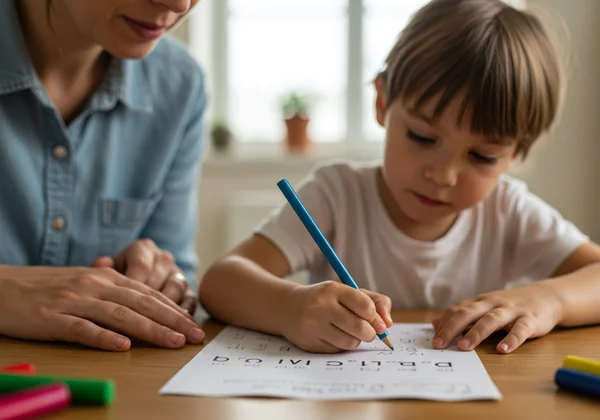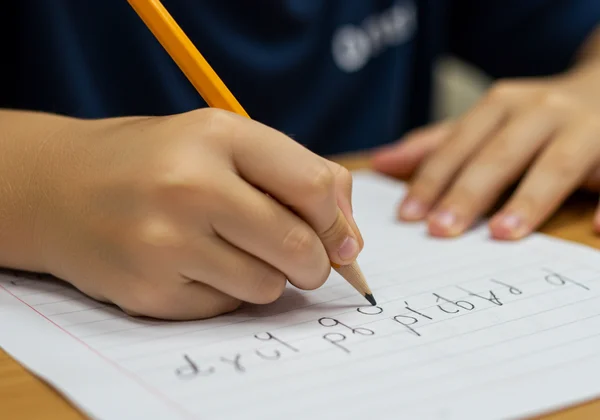Letter Reversals: A Dyslexia Screening Sign or Normal Development?
As a parent, you watch your child’s every developmental milestone with a mixture of pride and anticipation. When they begin to write, seeing their thoughts take form on paper is magical. But then you notice it: the 'b' is a 'd', the 'p' looks like a 'q', and some words are written in mirror image. Your heart skips a beat, and a question surfaces—is this a normal part of learning, or is it a sign of something more? This guide unpacks the common parental concern around letter reversals. We'll explore the question, "What are the signs of dyslexia in a 7-year-old?" and help you understand when to be patient and when it might be time to seek more clarity. Gaining understanding is the first step, and a great place to start is with a simple free dyslexia screening.

Understanding Typical Letter Reversals in Child Development
First and foremost, take a deep breath. Seeing a child write letters backwards is incredibly common, especially in the early stages of literacy. Our brains are naturally wired to recognize objects regardless of their orientation—a chair is still a chair whether it's facing left or right. Letters, however, are unique; their orientation completely changes their identity. It takes time and practice for a young brain to master this complex new rule.
When Are Letter Reversals Like 'b' and 'd' Normal?
The classic b and d confusion is a hallmark of early writing for many children. Generally, letter reversals are considered a normal developmental phase for children up to the age of seven. During kindergarten and first grade, as children are cementing their knowledge of the alphabet, these mix-ups are expected. They are not an immediate red flag but rather a sign that a child's brain is working hard to learn the intricate rules of written language. Most children naturally outgrow this tendency as their visual processing and directional skills mature.

Why Young Children Might Reverse Letters
There are several cognitive reasons why a young learner might flip their letters. It's rarely about carelessness and more about the developmental stage of their brain. For one, visual-spatial processing is still developing. Distinguishing between two symbols that are mirror images of each other requires sophisticated visual discrimination skills. Additionally, children are still developing directionality—a solid internal sense of left and right. This can make it tricky to remember which way a letter should face. Without automatic recall, a child is essentially drawing a shape from memory, and it's easy to get the orientation wrong.
Persistent Letter Reversals: When to Consider a Dyslexia Screening
While occasional reversals are normal, persistence is the key factor to watch. If your child is past the age of seven or eight and still frequently reverses letters and numbers, it may be time to look a little closer. This is when a letter reversal can shift from being a developmental hiccup to a potential dyslexia sign. The concern isn't about a single instance but about a consistent pattern of difficulty that doesn't improve with typical classroom instruction. It’s important to see these signs not as a final verdict, but as a prompt to gather more information through an online dyslexia test.
Key Indicators That Go Beyond Normal Developmental Errors
How can you tell the difference between a normal phase and a potential issue? Look for a cluster of signs, not just one. Key indicators that may suggest an underlying difficulty like dyslexia include:
- Persistence Past Age 7/8: The most significant indicator is when reversals continue well into second or third grade.
- High Frequency: The child reverses letters in their writing more often than not.
- Lack of Self-Correction: They don't notice the error even when it's pointed out, or they struggle to correct it.
- Accompanying Difficulties: The reversals occur alongside other struggles, such as difficulty learning the alphabet, trouble with rhyming, or a slow, choppy reading pace.
These persistent reversals suggest that the difficulty may be rooted in how the brain processes language, which is a core characteristic of dyslexia.
Other Signs of Dyslexia to Watch For in Young Children
Dyslexia is much more than just reversing letters. It is a language-based learning difference that can affect reading, writing, and spelling. If you are concerned about letter reversals, it’s helpful to look for other common signs of dyslexia in young children. These often relate to phonological awareness—the ability to recognize and work with the sounds in spoken language.
Consider if your child also exhibits challenges such as:
- Difficulty recognizing rhyming words (e.g., cat, hat, bat).
- Trouble breaking words down into sounds (segmenting) or blending sounds to make words.
- Mispronouncing familiar words or using "baby talk."
- Struggling to remember sequences like the days of the week or the alphabet.
- A strong dislike of reading or writing activities.
If you see a pattern of these signs alongside persistent letter reversals, it’s a clear signal that taking the next step to assess reading skills is a wise and proactive choice.

Your Next Steps: Gaining Clarity with an Online Dyslexia Screening
Feeling concerned is natural, but feeling empowered is better. The goal is not to label your child but to understand their unique learning profile so you can provide the right support. An online dyslexia screening is an accessible, stress-free first step to transform your worries into an actionable plan. These tools are designed to identify potential risk factors and give you the preliminary insights needed to move forward.
The Role of Online Screening Tools in Early Identification
It's vital to understand that an online screening isn't a formal diagnosis. A formal diagnosis can only be made by a qualified professional, like an educational psychologist. However, a high-quality online dyslexia screening tool plays a vital role in early identification. It analyzes patterns in your answers about your child's reading and writing habits to provide a risk assessment. This report can help you:
- Validate Your Concerns: It can confirm if your observations align with common patterns seen in dyslexia.
- Provide a Starting Point: The results give you a concrete basis for discussions with teachers.
- Suggest Next Steps: A good screening tool will offer guidance on what to do next, empowering you on your journey.
Preparing to Speak with Educators or Professionals
Armed with the results from a screening, you can approach your child's teacher or school with more confidence. Instead of saying, "I think my child might have dyslexia," you can say, "I've noticed my child struggles with A, B, and C, and we completed an online screening that indicated a potential risk. Can we discuss what support is available?" This shifts the conversation from worry to collaboration. Having this information helps you advocate effectively for your child's needs. If you are ready to take that first step, you can try our free tool today.
Empowering Your Child's Learning Journey: Understanding Letter Reversals
In the end, whether your child's letter reversals are a temporary phase or a sign of dyslexia, your observation is a testament to your love and attention. Remember that dyslexia has nothing to do with intelligence; many of the world's most brilliant minds are dyslexic. The key is early understanding and support. By distinguishing between normal development and persistent challenges, you can provide the targeted help your child needs to thrive.
Don't let uncertainty hold you back. Empower yourself with knowledge and take the first, simple step toward unlocking your child's full reading potential. Visit our homepage to take a free dyslexia test and gain the clarity you and your child deserve.
Frequently Asked Questions About Letter Reversals & Dyslexia
Is an online dyslexia test accurate for letter reversal concerns?
An online dyslexia test is an excellent screening tool for concerns about letter reversals. It helps determine if the reversals are happening in isolation or as part of a broader pattern of language-based challenges that are consistent with dyslexia. While it's not a formal diagnosis, its accuracy lies in its ability to identify risk factors and guide you toward the right next steps, such as speaking with your child's teacher or seeking a professional evaluation. You can get your results in minutes.
What are other common signs of dyslexia in a 6-7 year old?
Beyond letter reversals, common signs in a 6-7 year old include difficulty sounding out words, trouble remembering sight words, and poor spelling. You might also notice they struggle with rhyming, have a hard time telling a story in the correct sequence, or read very slowly and hesitantly. They may also complain that reading is too hard or actively avoid it.
Can my child's school test for dyslexia?
Yes, schools can and should provide support, but the process may vary. Public schools can conduct an educational evaluation to determine if a child qualifies for special education services under a category like "Specific Learning Disability." While they may not use the specific term "dyslexia," the assessment identifies the underlying processing issues. A formal clinical diagnosis, however, is often done by an outside specialist, such as a neuropsychologist. The first step is always to formally request an evaluation in writing from the school principal.